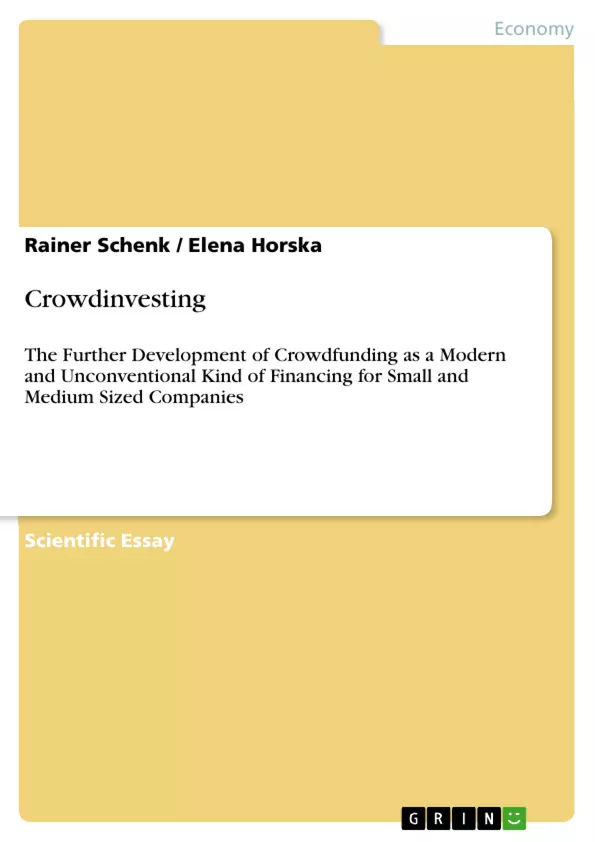Currently, and especially after the recent global financial crisis, it has become not easier for companies to get financial resources for their specific investments . In particular it is difficult to get conventional and traditional loans by banks to finance start ups or special and innovative projects of entrepreneurship. For this reason it is important to find new ways of financing. For this purpose, it seems useful, to modify the relatively new “Crowdfunding” mainly and so far used for financing artistic projects into an appropriate kind of corporate financing, called “CROWDINVESTING”. The following paper would theoretically develop the Crowdinvesting and encourage it to use in everyday business of SMEs .
Keywords: Crowdfunding, crowdinvesting, corporate finance, credit clamp, funding, lending, SME;
Table of Contents
- Abstract
- Introduction
- The historical development of Crowdfunding as the origin of a reorientation for Crowdinvesting
- Objective of the essay
- Crowdfunding in Europe using the example of Germany
- How does CF function as a pre-form of Crowdinvesting?
Objectives and Key Themes
This essay aims to explore the potential of Crowdinvesting as a modern and unconventional financing method for small and medium-sized enterprises (SMEs). It examines the historical development of Crowdfunding and its evolving application as a form of corporate finance.
- The evolution of Crowdfunding from its initial use in artistic projects to its potential as a source of corporate finance.
- The challenges faced by SMEs in accessing traditional financing methods and the need for alternative options.
- The characteristics and benefits of Crowdinvesting as a financing mechanism for SMEs.
- The role of Crowdinvesting in promoting social responsibility and public participation in business ventures.
- The potential of Crowdinvesting to address the financial gap faced by SMEs and foster innovation.
Chapter Summaries
The essay begins by outlining the current financial challenges facing SMEs, highlighting the difficulty in obtaining traditional loans for start-ups and innovative projects. It then introduces Crowdinvesting as a potential solution, a concept that modifies the existing Crowdfunding model to better suit the needs of companies.
The essay delves into the historical development of Crowdfunding, tracing its origins in the USA and its initial application to finance artistic projects. It discusses the idea behind Crowdfunding and its reliance on the collective support of a "crowd" who are motivated to contribute to projects through the internet.
The essay explores the objective of the paper, which is to analyze the premises and principles of Crowdfunding and demonstrate how it can be adapted into a viable form of Crowdinvesting for corporate finance. It suggests that Crowdinvesting has the potential to create a "people's share" in companies, reversing the traditional principles of capitalism and fostering social responsibility.
The essay then examines the current state of Crowdfunding in Europe, using Germany as an example. It discusses the emergence of online platforms for Crowdfunding projects and the growing number of initiatives in Germany. The essay highlights the potential of Crowdinvesting to further enhance the market potential of Crowdfunding in Germany.
Finally, the essay explains how Crowdfunding functions as a precursor to Crowdinvesting. It details the mechanisms of Crowdfunding, including the rewards offered to investors, the low-risk nature of the investments, and the "all-or-nothing" principle that ensures the success of projects. The essay also discusses the benefits of Crowdfunding for entrepreneurs, including access to market research and the potential for increased visibility and support.
Keywords
The main keywords and focus topics of the essay are: Crowdfunding, Crowdinvesting, corporate finance, credit clamp, SME, innovative financing, social responsibility, public participation, market potential, financial gap.
- Quote paper
- Rainer Schenk (Author), Prof. Dr. Ing. Elena Horska (Author), 2012, Crowdinvesting , Munich, GRIN Verlag, https://www.grin.com/document/192959



